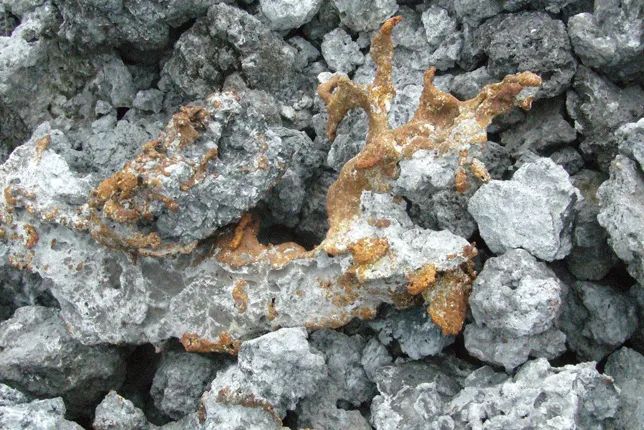Reaction mechanism and application of steel slag-fly ash-desulfurized gypsum composite cementation system

As typical bulk industrial wastes, the massive discharge and storage of steel slag, fly ash, desulfurized gypsum, etc. bring serious harm to the environment. The use of steel slag, fly ash, and desulfurized gypsum to prepare inorganic cementitious materials to replace part of cement for industrial production can not only promote the large-scale disposal of industrial solid waste, but also achieve the purpose of reducing cement production and consumption, and saving costs.
Fly ash is a solid waste discharged during the combustion process of coal-fired power plant boilers. A series of physical and chemical changes such as cooling, the fine particles are discharged from the flue gas pipeline and captured. The gelation of fly ash in the preparation of cementitious materials mainly depends on its pozzolanic properties, that is, the properties of active Al2O3 and SiO2 in fly ash react with Ca(OH)2 to form C-S-H and C-A-H gels under hydrothermal conditions . Pulverized coal furnace fly ash contains less calcium, and it does not have gelling properties by itself. The circulating fluidized bed fly ash contains a certain amount of CaO/Ca(OH)2, which has a certain degree of hydration and self-hardening.
Steel slag is the waste slag produced by the carbon, silicon, sulfur, phosphorus, manganese and other impurities in molten steel removed by oxidation and slagging at high temperatures above 1600 °C during the steelmaking process. The mineral composition of steel slag is closely related to its alkalinity [A=mCaO/m(SiO2+P2O5)], which is mainly related to the formation process of steel slag, because in the process of steelmaking, some metal elements such as Fe, Mn, and Mg in molten steel are removed. Oxidation to generate FeO, MnO and MgO, etc., silicon element is oxidized to SiO2, and CaO generated by the decomposition of flux, thereby forming CaO-SiO2-RO (where R is Fe2+, Mn2+, Mg2+ and other divalent metal ions, due to Their ionic radii are close, and it is easy to form a continuous solid solution) system. The steel slag is classified according to the alkalinity: when the alkalinity A is 0.9-1.4, the steel slag is mainly calcium magnesium olivine slag; when the alkalinity A is 1.4-1.6, the steel slag is mainly magnesium rose pyroxene slag; When A is 1.6-2.4, the steel slag is mainly dicalcium silicate slag; when the basicity A>2.4, the steel slag is mainly tricalcium silicate slag. At the same time, steel slag (especially high-basicity steel slag) has a mineral composition similar to cement, such as C2S, C3S and a small amount of C3A, C4AF, etc. These minerals themselves can undergo hydration reaction, so that steel slag has certain cementitious properties.
Desulfurized gypsum, also known as flue gas desulfurized gypsum, is an industrial by-product gypsum obtained after desulfurization and purification of flue gas generated by burning sulfur-containing coal in boilers in coal-fired power plants. The composition of desulfurization gypsum is mainly CaSO4·2H2O, and the content is generally 92%-95%. Because desulfurized gypsum contains a small amount of impurities such as calcium carbonate, dolomite, muscovite, and fly ash, desulfurized gypsum generally appears yellow. Adding a certain amount of desulfurized gypsum to the composite cementitious material will have some positive effects on the performance of the cementitious material. The main mechanism of action of desulfurized gypsum on composite cementitious materials is as follows:
1) Desulfurized gypsum is used as an active activator for mineral raw materials and admixtures in composite cementitious materials, and desulfurized gypsum plays the role of sulfate activation.
2) Desulfurized gypsum is a sulfate, which can react with Ca(OH)2 and aluminum-containing phases produced by cement hydration to form ettringite crystals. The ettringite crystals grow inside the cementitious material, filling the pores continuously, improving the density of the material and improving the mechanical properties of the material;
3) Delay the setting time of the cementitious material. Desulfurized gypsum can have a certain retarding effect on some minerals (such as C3A) that hydrate faster. This is because the ettringite crystals generated by the desulfurized gypsum are wrapped on the surface of the mineral particles. It isolates the water and reduces the penetration rate of water, thus playing a role in slowing down the hydration and condensation of minerals.
4) Crystallization effect. Studies have shown that the addition of desulfurized gypsum to the cementitious material helps to accelerate the precipitation of the crystals of the hydration product of the cementitious material, shorten the induction period, and thus accelerate the growth of the compressive strength of the cementitious material. It should be noted that the amount of desulfurized gypsum incorporated in the composite cementitious material should not be too large, generally below 10%. This is because too much desulfurized gypsum may generate more ettringite in the later stage of hardening of the cementitious material, resulting in volume expansion, which may eventually lead to expansion and cracking of the hardened body of the cementitious material.
